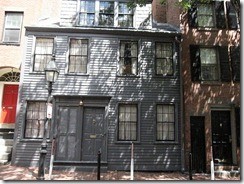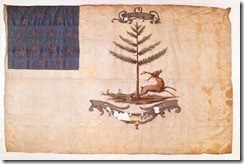George Middleton House (Black Heritage Trail Site 2)
Introduction
Text-to-speech Audio
Images
The outside of the Middleton House. The home is privately owned.

The Flag presented to the Bucks of America

Backstory and Context
Text-to-speech Audio
George Middleton built the wooden two-story home in 1786-1787 with his good friend, Louis Glapion. Glapion was a hairdresser from the French West Indies who ran his business out of their shared home. Little is known about Mr. Glapion, however, George Middleton is well known as a leader in Boston's African American community in the years during and after the American Revolution. Middleton married Elsey Marsh in 1781 and the census of 1790 lists Middleton's home as having three inhabitants, but little more is known about his family.
Middleton's history is most noteworthy because of his service during the war when he led a militia called the Bucks of America, an African American group of soldiers based in Boston with Middleton as Colonel. John Hancock, the governor of Massachusetts at the time, gave the company a white silk flag as an award of appreciation for their service. The flag is painted with the initials J.H. and G.W. (John Hancock and George Washington) and includes pictures of a pine tree, a deer, and a scroll. Today, the flag is owned by the Massachusetts Historical Society. Washington initially opposed Black militia but later changed his mind owing to the opinions of other military leaders who valued Black manpower. Black leaders like Middleton were savvy in convincing the political and economic elite to support their militia by offering to guard the homes of Boston merchants during the war.
Middleton became an early member of the Prince Hall African Lodge of Freemasons and in 1809, he became the third Grand Master of that Africa American fraternal organization. Middleton was also fundamental in the establishment of the Boston African Benevolent Society. Both organizations were designed to help African Americans obtain equal rights in the community but also to secure mutual protection and economic support for members.
One of the most important causes in Middleton's later life was the treatment of Black children in the schools. He fought hard until the end of his life in 1815 to secure monetary support for Black schools while also challenging the exclusion of Black pupils.
The single-family house at 5 Pinckney Street is the oldest extant home on Beacon Hill. Today, the home is privately owned and not accessible to the public.
Cite This Entry
Ritz, Erin and David J. Trowbridge. "George Middleton House (Black Heritage Trail Site 2)." Clio: Your Guide to History. October 28, 2017. Accessed March 18, 2025. https://theclio.com/entry/7104
Sources
Jones, Kevin Trimell. Col. George Middleton: Black Revolutionary War hero. The Bay Area Reporter. October 20, 2011. Accessed March 06, 2017. http://ebar.com/news/article.php?sec=news&article=6135.

